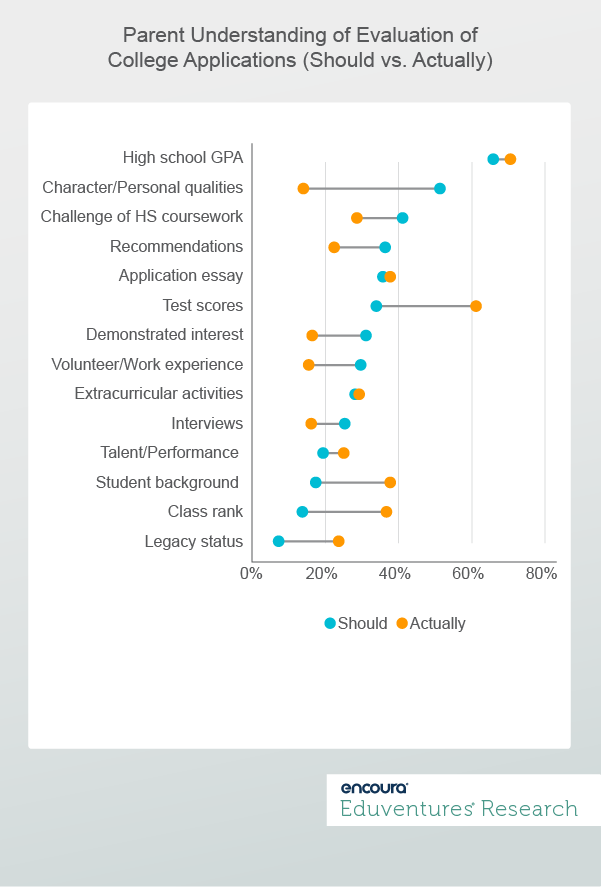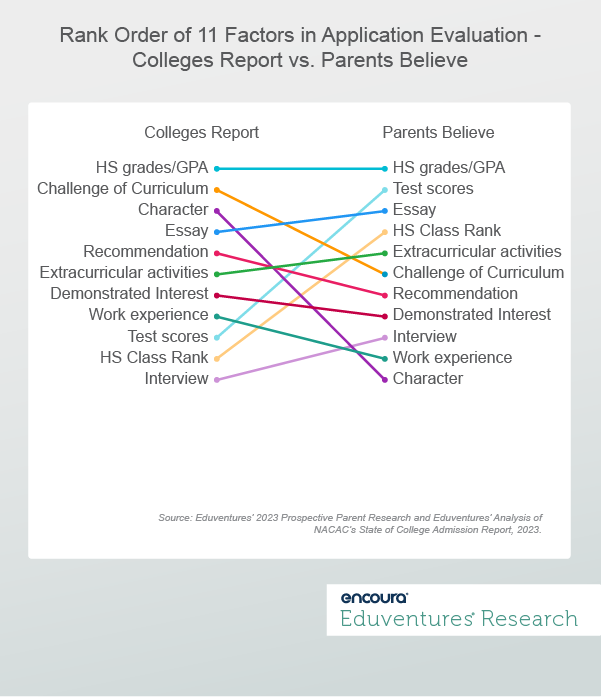Colleges with selective admissions have a considerable PR problem. Eduventures’ Prospective Parent Research™ indicates that about one third of parents (34%) believe that schools should be using test scores when evaluating college applications, yet nearly two thirds (61%) believe schools actually do so. This is just one of many perception gaps.
Changes in admissions criteria over time—especially the scaled back use of standardized tests triggered by COVID-19—are not necessarily seen, or trusted, by prospects. What, if anything, can colleges do to rebuild trust when it comes to admissions criteria?
Eduventures’ Prospective Parent Research explores parent perceptions of the criteria that colleges use to evaluate undergraduate applications. Figure 1 shows critical disparities in the criteria parents believe colleges should use and the criteria they actually use to evaluate applications.
Figure 1.
Figure 1 indicates that parents do believe that colleges use high school GPA as a primary factor, and that this is the right focus. Beyond this, parents don’t believe colleges are placing the correct weight on many other admissions criteria.
In addition to the significant gap on test scores, about half (51%) of parents think that colleges should consider a student’s character, while only 14% believe that colleges actually do so. On average, parents believe that colleges are more focused (38%) on student background (income, race, region, etc.) than they should be (17%). Likewise, they believe that colleges are more focused on class rank (37%) and legacy status (24%) than they should be (17% and 14%, respectively).
But how do parent beliefs about college admissions criteria compare to what colleges report doing? The National Association for College Admission Counseling (NACAC) gathers insight on college admissions criteria in its State of College Admission Report allowing us to compare 11 criteria that are similar between NACAC’s report and our Prospective Parent Research.
In Figure 2, we’ve ranked the NACAC items by the degree to which criteria are reported as considerably or moderately important to colleges. We’ve also ranked the items in order by what parents believe that colleges focus on for each factor in admissions. This analysis shows the big gap in the understanding of current admissions evaluation policies.
Figure 2.
In Figure 2, we can see that there again is agreement on the primary importance of high school grades. Beyond that, the PR problem emerges.
Colleges say they place much less emphasis on standardized test scores in their overall admissions decisions than parents imagine. A decade ago, 58% of institutions said test scores had considerable importance. Thanks largely to the pandemic, this view is shared by just 5% of schools.
Yet, this stance remains unseen or untrusted by families. It is rational for a parent to believe that a submitted score would, in fact, be considered. Why submit something that isn’t important? One of the key challenges for institutions is to explain their complex test submission policies in a straightforward way that is believable to families.
Notably, the COVID-era sentiment on the use of standardized tests has shifted since this research was conducted. A growing number of highly selective public and private universities have reinstated the use of test scores in admissions. This latest trend, however, may only exacerbate the lack of understanding of admissions policies among families.
In Figure 2, class rank is another metric that has declined in use over time (15% in 2013, 5% in 2023). It’s ranked 10th in our analysis for colleges, but 4th in terms of parents’ beliefs about college use.
At the same time, parents don’t believe that colleges are doing much to consider the character of their children. They rank college use of this factor dead last, while colleges themselves rank it 3rd.
What are we to make of this parental emphasis on character? It probably represents overall frustration among parents with selective admissions colleges. Their inclusive thought that “my child is a good person and deserves a place at a good school,” runs counter to the exclusive black-box admission decision. The emphasis parents place on character is perhaps a cry for help in the face of immense uncertainty about college decisions.
The Bottom Line
Higher education’s evolving admissions policies are not well understood by parents. Optimistically, perhaps there is a lag in understanding. Pessimistically, perhaps the above data exposes tremendous distrust of black-box decision making.
This mismatch of understanding is likely a combination of both—we have a gray box situation. Colleges try to explain their processes, but the message is not getting through or is obscured by complexity. What can colleges do to rectify this fractured perception of college admissions? Here are some thoughts:
- Build both understanding and trust. It won’t be enough to clinically explain how you are evaluating applications, you must also establish a relationship of trust with families.
- Approach admissions with maximal transparency. The most appropriate way to build both understanding and trust is through transparency about your evaluation process. You might not reveal all but reveal as much as you can.
- Evaluate your practices for alignment to market desires. Which of your selection criteria matches up to family desires for a fair evaluation. Highlight the ways that you meet their needs.
- Explain practices that differ from market desires thoughtfully. There are always legitimate circumstances where you want to use criteria that are viewed unfavorably by parents or students. In these instances, you must explain and provide evidence for why your criteria are important.
Of course, not every institution uses the same criteria, and not every parent expects this. Future Eduventures research will detail market expectations for admissions criteria with attention to specific types of institutions and key demographic segments.



